Looking for tampons and period products that are free of toxic chemicals and unnecessary plastic waste? You’ve come to the right place. Here is our list of the best non-toxic period products, plus what to look out for when selecting eco-friendly tampons.
Table of Contents
I distinctly remember being a pre-teen and being handed a plastic packet with samples of plastic-wrapped tampons, pads, and pantyliners one day at school. Even then I was taken aback by the amount of plastic waste used to wrap up these items, and I had the vague sense that the plastic wasn’t just for hygiene reasons but to hide these products from sight. It took a few years for me to figure out that there were alternative ways to manage my period, ways that are healthier for me and for the planet, but now I know, there’s no going back.
See also: Toxins in Tampons and Pads 101
Always, Tampax, and o.b. are the big names in period products, but these have all been found to contain undesirable chemicals and have a significant environmental impact.
Given that menstrual management products aren’t something you can simply choose not to use, what’s the alternative?
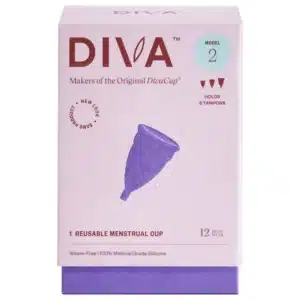
Best menstrual cup
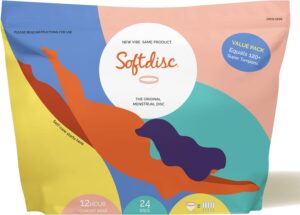
Best menstrual disc
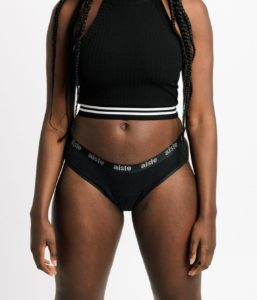
Best period underwear
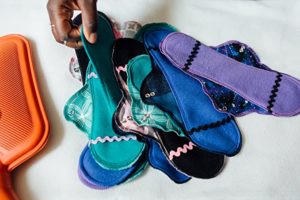
Best reusable period pads
Aisle Period Pads (formerly known as Lunapads) [staff tested]
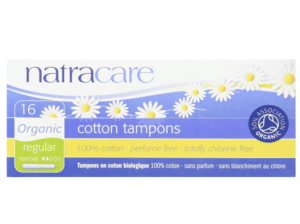
Best organic cotton tampons
Free eBook: Simple Steps to a Greener Home
Concerned about climate change? Learn actionable tips for making each room in your home greener.
"*" indicates required fields

The best non-toxic menstrual cups
For many people, menstrual cups are the simplest solution.
Often paired with reusable or disposable pantiliners for back-up support, menstrual cups come in all shapes and sizes and are simple to use, once you get the hang of it. Made from silicon or latex, these reusable cups sit in the vaginal canal where they collect menstrual fluid instead of absorbing it.
Non-toxic and comfortable to use, for most people, menstrual cups are a great option. They typically last two to five years, making them more eco-friendly, healthier, and inexpensive way to manage periods. With proper care, a single menstrual cup could last you decades.
Proper care for a menstrual cup means cleaning it thoroughly after each period. Most manufacturers recommend putting a silicon cup in a pot of rapidly boiling water for 5-10 minutes, making sure the holes near the top of the cup are clear of gunk (use a toothpick if necessary). Then, let the cup air-dry in a sunny spot before storing it in a breathable bag. If your cup starts to look discolored, smell funny, feel sticky, or has a powdery film, it’s time to replace it. Different cups have different care protocols however, so be sure to follow manufacturers’ instructions.

Diva Cup
Highlights: Usable for up to 12 hours with leak-free protection for most, and lasts for up to a decade if properly cared for.
DivaCup is arguably known as the industry leader when it comes to eco-friendly period products. The cup itself is made from medical-grade silicone that comes in two different sizes. As long as the shape and size are dialed in for each individual person, you shouldn’t be able to feel this cup while it’s in use. Maintenance is fairly straightforward; you’ll want to wipe it and rinse it with warm, soapy water each time it’s emptied, then boil it for five minutes at the end of each period. If this protocol is followed, you should be able to get up to ten years – or more – of use out of it!
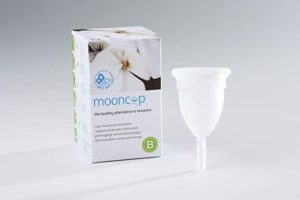
Moon Cup
Highlights: Comes in two different sizes made to be able to handle heavy and light flow.
Created in the UK and sold for the first time back in 2001, Moon Cup is the first silicone menstrual cup that hit the market and paved the way for other menstrual cup makers. It’s hypoallergenic, durable, non-toxic, latex-free, and eco-friendly thanks to the medical-grade silicone it’s made of. The makers of Moon Cup, in addition to making a great product, have a demonstrated commitment to environmental and social initiatives from running their own Advice Line that’s staffed by medical personnel, to their ethically sourced and produced packaging and more.
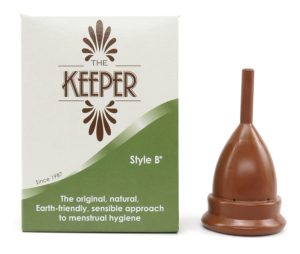
The Keeper
Highlights: One of the oldest menstrual cup brands around! The Keeper is made up of latex made from gum rubber as opposed to medical-grade silicone.
Introduced back in 1987, The Keeper is the oldest menstrual cup brand around. Where most of its competitors use medical-grade silicone to create their products, The Keeper is made of latex from gum rubber. This composition can change up the maintenance process though; where its competitors recommend boiling the product for sanitizing, makers of The Keeper recommend rinsing the cup in warm soapy water, and then in a solution made of one part vinegar to nine parts water.
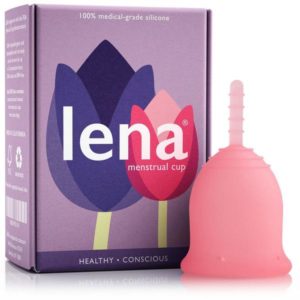
Lena
Highlights: Typically more affordable than other menstrual cups of similarly high quality, and offered in three different sizes.
Lena’s products are made with medical-grade silicone and dyes, offering similarly high quality as some of their competitors, but at a more affordable price point. Its seamless ridge makes insertion easier than with some of the other cups on the market, and its slanted suction holes make it much easier to clean. With all that being said, some users find that because it’s a little stiffer than some of its competitors, it can be easy to insert, but a little more difficult to remove.
Free eBook: Simple Steps to a Greener Home
Concerned about climate change? Learn actionable tips for making each room in your home greener.
"*" indicates required fields

The best non-toxic menstrual discs
Other options for non-toxic menstrual products include disposable menstrual discs. Currently only available as SoftDisc or SoftCup in the U.S., menstrual discs are similar to menstrual cups in that they collect blood internally. However, these discs are made of thinner material, sit higher in the body (closer to the cervix), and are discarded after each use.

SoftDisc (which you may see as SoftCup elsewhere) is a BPA and latex-free disc that holds the equivalent of five regular or three super tampons worth of fluid. Like the menstrual cups above, they’re capable of being used for up to 12 hours a time, but these are disposable and thrown away after use as opposed to being washed and sanitized. If you’re on the fence about jumping into the world of menstrual cups, these discs can help test the fit and feel of using one before committing to a reusable cup while still being ultimately less wasteful than traditional disposable tampons.
The best non-toxic period underwear
Period underwear is another great option for eco-friendly, non-toxic menstrual management, especially for those who don’t want to use internal period products.
Made with absorbent natural fibers, period underwear can be worn with or without inserts for extra support and simply need rinsing in cold water and washing with your regular laundry after use. As with menstrual cups, period underwear costs more upfront than disposable tampons and pads but saves you money in the long-run, is arguably healthier, and is better for the environment. Try to choose period underwear made with organic cotton though, as conventional cotton is resource-hungry, may contain traces of pesticides and other chemicals, and is bad for the environment.

Aisle (formerly known as Lunapads)
Highlights: Eco-friendly, non-toxic period underwear made from organic and recycled materials from the B Corp formerly known as Lunapads.
Aisle offer a wide range of period underwear styles for all bodies, whatever your gender, shape, or size. They have briefs, boxer briefs, hipster style and bikini style period underwear in XS to 5X sizes with absorbency up to as much as four tampons’ worth. The period underwear is made of organic cotton, recycled polyester, and Tencel, and each pair comes with an absorbency booster liner for heavier days, meaning these may well be the only pair of period underwear you need.
Aisle use Oeko-Tex Standard 100 materials in their pads and underwear, with no PFAS chemicals. Body: Tencel /organic cotton /spandex. Lining: recycled polyester /organic cotton /polyester /TPU laminate.
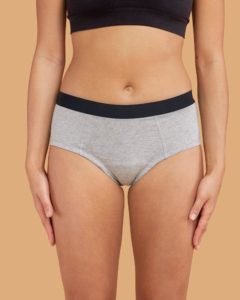
Thinx Organic Cotton Period Underwear
Highlights: A well known name in period underwear, Thinx have recently launched a more sustainable organic cotton version of their range.
Thinx offer bikini, brief, and a thong version of their organic cotton period underwear with absorbency up to the equivalent of five tampons in the briefs. The underwear has a leak-resistant moisture barrier and looks like everyday underwear. Available in XXS to 3XL sizes and in three colors.
The Thinx organic range is made with GOTS certified organic cotton, elastane, and a polyurethane layer with OEKO-Tex 100 certification. Be sure to get the organic option as most Thinx underwear is not sustainable or organic. This period underwear can be machine washed cold and hung to dry.
Thinx also now offer a reusable tampon applicator (view re.t.a at Thinx) that accommodates regular and super tampons. It is made with “medical-grade materials” which appear to be silicone rather than latex or plastic with BPA. Unfortunately, it’s quite pricey at around $77, though reusing this applicator over many years would quickly become cost effective compared to the price of tampons with applicators versus those without.

Sustain Period Underwear
Highlights: Sustainable period underwear made in the USA by a certified B Corp in a good range of sizes but with less absorbency than Aisle’s underwear.
Sustain are an American B Corporation making brief-style period underwear in sizes XS to XL. While useful, these period panties are less absorbent than some other options, managing just one tampon’s worth of blood.
Best suited for lighter days or as a back-up if using a cup, disc, or tampon, Sustain period underwear is made with 95% GOTS certified organic cotton and 5% Spandex for the body with a polyurethane laminate lining topped with 100% organic cotton.
Free eBook: Simple Steps to a Greener Home
Concerned about climate change? Learn actionable tips for making each room in your home greener.
"*" indicates required fields

The best non-toxic reusable period pads
Reusable pads are also a great choice for eco-friendly period management. Available in a variety of shapes, sizes, and patterns, reusable pads and inserts are made with cotton and, sometimes, a thin leak-proof layer of polyurethane laminated polyester (PUL). While PUL is a type of plastic, it is often certified non-toxic and safe for use. And, as these products are used time and again, the environmental impact is a lot lower than that of conventional plastic pads and synthetic tampons, as well as all-cotton disposable tampons and pads.

Aisle (formerly known as Lunapads)
Highlights: Made by a company committed to donating pads and supporting charitable initiatives worldwide, these pads are soft, breathable, and can last for at least three years if properly cared for.
Aisle / Lunapads are a major player in the world of eco-friendly menstrual management that offers everything from reusable period pads and liners to other personal care products that are good for the environment and your health. They carry a whole host of certifications (BBB accredited, Climate Smart Certified, Green America Approved, and more) and are committed to pad donations and charitable cloth pad initiatives across the world. The pads themselves are made from 100% organic cotton, and should last at least three years when cared for properly.
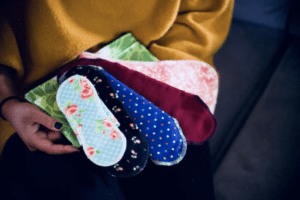
GladRags
Highlights: GladRags products are packaged using recycled/recyclable and/or biodegradable materials, and the pads themselves tend to be reusable for around five years if properly cared for.
Unlike Lunapads, GladRags have been around since 1993. They’re a Leaping Bunny Certified Cruelty-Free company, a certified B Corporation as of 2012, and they’re incredibly transparent about their environmental reports. All of their products are packaged using materials that are biodegradable, recycled, recyclable, or some combination thereof. For the pads themselves, Lunapads uses an envelope-like system that secures inserts inside of a pad holder, which then clips around underwear to make for a much more secure system overall.
Reusable tampons
Reusable tampons are not currently available in the U.S., but Imse Vimse sell these in the UK. Made with organic cotton, these reusable tampons work like regular tampons and need to be rinsed, washed, and boiled between uses. If you struggle to use a menstrual cup, but want an internal method of menstrual management, reusable tampons may be worth a try.
The best organic cotton tampons and pads
If reusables simply aren’t your thing, disposable all-cotton organic tampons and pads are available. These typically limit your exposure to pesticides, dyes, perfumes, and toxins and have been around since the 1980s, when NatraCare introduced their first line of all-cotton organic tampons and pads.
It’s worth noting, though, that when it comes to tampons and pads, ‘organic’ just means made with organic cotton that has not been bleached using chlorine. Products are not necessarily free of perfumes, dyes, or other chemicals, and the ‘natural’ label means next to nothing in regard to tampons and pads. As such, it’s important to check with the manufacturer that products are free from dyes, bleached using hydrogen peroxide (or unbleached), and have USDA-recognized organic certification. Other certifications are also important here, such as Quality Assurance International (QAI) and the Global Organic Textile Standard (GOTS) (see more on certifications here).
In one study, all-cotton tampons and menstrual cups were the only products tested that did not appear to promote the growth of Staphylococcus aureus MN8, the bacteria responsible for TSS. All of the other tampons (and diaphragms and contraceptive sponge) promoted the growth of the bacteria. One other interesting finding from this study was the apparent breakdown of an older type of tampon (Rely), which suggests that it’s best to avoid using older synthetic tampons (R).
Whichever type of tampon you use, they should be changed at least every 4-8 hours. Even organic all-cotton tampons and reusable tampons pose a risk of TSS. Always use the lowest absorbency level to meet your needs, and don’t use a single tampon for more than 8 hours or when you’re not actively menstruating.
Although I pretty much exclusively use a menstrual cup and reusable pads for period management these days, I like to keep organic, non-toxic tampons, pads, and pantyliners on hand in case guests get caught out when visiting. And, frankly, these are sometimes more convenient when overnight camping or otherwise adventuring away from home.

NatraCare
Highlights: The world’s first fully certified organic tampons, free of synthetic materials and chemical additives.
LeafScore’s go-to brand for disposable tampons, pantyliners, and pads, and the world’s very first fully certified organic tampons. They’re free of synthetic materials and chemical additives, and made from 100% USDA-certified organic cotton. Regular, super, and super plus absorbency options are available to be picked from, and all three are offered in applicator and non-applicator versions. While these are probably the most readily-available organic tampons you’ll find, they can run a bit pricier than regular tampons, so it’s best to buy in bulk online!
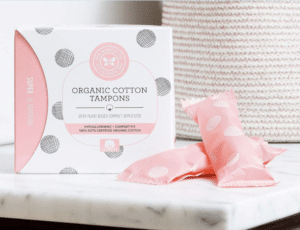
The Honest Company
Highlights: Tampons are hypoallergenic and made from 100% GOTS certified organic cotton, and the applicator is made of at least 90% plant-derived materials.
The Honest Company is one that we’re definitely keeping an eye on as they quickly grow to offer exciting new products with impressive eco-credentials. These tampons in particular are hypoallergenic and made with 100% GOTS-certified organic cotton. In addition to this, their applicator is made of at least 90% plant-derived materials with no phthalates, but unfortunately does contain plastic. With that said, the company is a certified B Corp that’s involved in advocacy work aimed at promoting better regulation of personal care products in the U.S., which places them in close competition with our product of choice, Natracare.
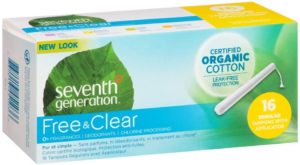
Seventh Generation
Highlights: Free from fragrances, deodorants, and chlorine processing. Its applicators are made with 95% plant-based materials and are BPA-free.
Another great contender for consideration, Seventh Generation tampons are quite similar to Natracare tampons – except for the applicator. Just like The Honest Company, the presence of plastic (that contributes to environmental pollution) within the otherwise plant-based applicator is just enough to make us look twice. Additionally, Seventh Generation was acquired by Unilever in 2016, which certainly doesn’t have that great of an environmental record. We have yet to see the kind of influence this big company might have on Seventh Generation, but so far these organic tampons are still immeasurably better than your standard disposable.
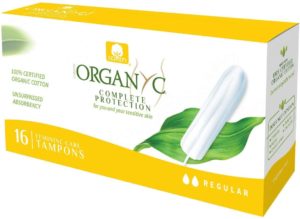
Organyc
Highlights: Breathable, hypoallergenic, and made from GOTS certified cotton, these tampons hold up well in tests against brands like Always and Tampax.
Free from chlorine bleach, latex, parabens, perfumes, SAP, plastics, and man-made materials, Organyc presents another contender for consideration in the organic tampon category. These hypoallergenic tampons are made with 100% organic tampons, and their packaging is made with biodegradable materials. They’re offered in three different absorbencies without applicators, and two absorbencies with applicators.
Non-toxic tampons FAQ
Research carried out by the French magazine 60 Millions de Consommateurs revealed in 2016 that 5 of 11 products tested contained traces of dioxins, insecticides, or other undesirable chemicals. Traces of halogenated waste, a by-product of manufacturing, were found in Tampax Compak Active Regular Fresh tampons and residues of organochlorine pesticides and pyrethroid insecticides were found in some Always sanitary towels. These manufacturers said the results were a “mistake” and blamed the testing process itself. Traces of dioxins were found in o.b. and Nett brand products.
Surprisingly, the researchers also found traces of glyphosate (the chemical in Roundup weed killer) in organic cotton sanitary towels made by Organyc. The company, who noted that organic cotton should be free from this herbicide, confirmed the results through their own tests and chose to voluntarily recall a batch of 3,100 boxes of sanitary towels on sale in France and Canada. Organyc said they would initiate comprehensive testing of their raw materials from their cotton suppliers, who are primarily based in the U.S. and India.